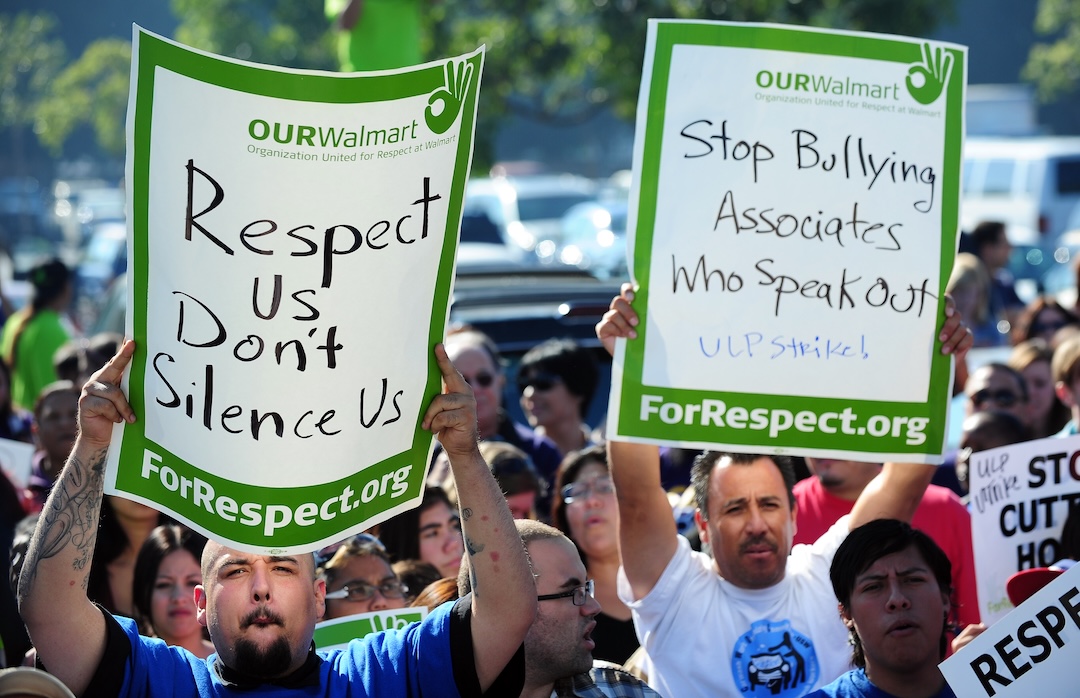“Premajority Unionism” Is Not a Promising Path for Labor
“Premajority unionism” is a new term for corporate campaigns, in which workers try to win concessions from employers using channels outside the workplace, like investor pressure and appeals to the public. Such efforts are not likely to achieve much.

Corporate campaigns and alt-labor agitating certainly can yield some wins here and there, but it is not always clear whether a given win is actually the result of a campaign. (Frederic J. Brown / AFP via Getty Images)
Over at Capital & Main, Jesse Baum has a report about the successes of “premajority unionism”:
What [Dollar General stocker David] Williams needed, he thought, was a better job. He wasn’t looking to unionize his workplace — a tall order in the right-to-work South. He just needed things to change.
In 2022, Williams joined an organization that seemed, to him, like his best shot: Step Up Louisiana. Like several successful campaigns before it, Step Up organizes workers to improve their jobs, but stops short of calling for a union under the National Labor Relations Board. The approach, sometimes referred to as “premajority unionism,” is a natural fit for places like the South, with histories of public hostility to unions. Today, suggest experts, it may also be workers’ best bet for building power amid the hostility of the Trump administration.
The story discusses three recently successful efforts to improve working conditions:
- After some of their employees engaged in public demonstrations and placed stories in the press, Dollar Tree (a) announced an average hourly wage increase of $2 over two years and (b) approved a shareholder proposal to conduct a safety audit, which ultimately found that safety at Dollar General stores is in line with the industry norm.
- After some Waffle House employees organized alongside the Service Employees International Union (SEIU), the company announced it was increasing pay from $2.13 an hour to $5.25 an hour by 2026.
- After some app-based delivery workers began lobbying as part of an organization called Los Deliveristas Unidos, New York City passed a city law mandating that delivery drivers be paid the minimum wage, which is $21.44 per hour in 2025.
Baum’s enthusiasm for these kinds of efforts is reminiscent of the excitement around worker centers and “alt-labor,” which reached its peak in the early 2010s. In this earlier form, there was a burst of reporting focused on organizations like the National Domestic Workers Alliance, the National Day Laborer Organizing Network, the Restaurant Opportunities Center, the New York Taxi Workers Alliance, and union-affiliated campaigns like OUR Walmart and Fight for $15.
The tactics of these older organizations and the organizations in Baum’s report also have an older name, which is the “corporate campaign.” In a corporate campaign, rather than try to win concessions through unionization, bargaining, and striking, you focus on channels outside the workplace, including investor pressure (like Williams’s shareholder proposal), governmental intervention (like NYC’s minimum wage rule), and appeals to the public (like public demonstrations and media stories).
When I began reading Baum’s piece and saw that she was writing about something she was calling “premajority unionism,” I thought she might be writing about the similarly named “minority unionism,” which refers to workplaces where a minority of workers band together and engage in National Labor Relations Act (NLRA)–protected activity aimed at improving working conditions despite the fact that they do not have the majority support necessary to form a certified union. But Baum’s coverage includes no examples of minority unionism, only examples of alt-labor groups engaging in corporate campaigns.
Corporate campaigns and alt-labor agitating certainly can yield some wins here and there, but it is not always clear whether a given win is actually the result of a campaign. Baum’s report basically assumes that all of the favorable changes that occurred after a particular bout of worker organizing were because of that organizing. But some of these changes — especially the modest Family Dollar and Waffle House raises — may have been implemented anyway, e.g., in response to the pressures of a tight labor market, inflation, and wage compression.
As to whether these other approaches are really a viable alternative to the National Labor Relations Board (NLRB) right now, I think it depends on what exactly is meant by that. Without the NLRA and the NLRB, there is nothing to stop companies from simply firing workers who speak out against working conditions as part of these corporate campaigns. Of course, even with the NLRB, there is little preventing a committed company from doing so given that the NLRB process takes so long and the penalties for violations are so weak. But what legal protection these workers may have at all from this sort of retaliation still comes entirely from the NLRB, even in its currently hobbled state.
Given all of this, my own opinion is that the sort of activism Baum is referencing is not likely to achieve all that much, which is something some of the experts quoted by Baum also said. “Premajority unionism,” so defined, is not a particularly new idea, and there is no reason to think it will be more potent today than it was fifteen years ago. What hope there is for the labor movement will ultimately need to come from elsewhere.